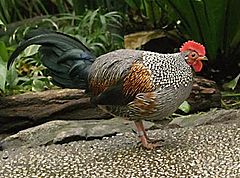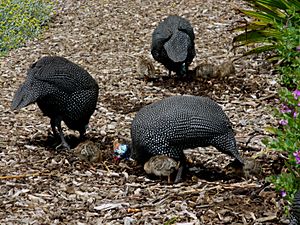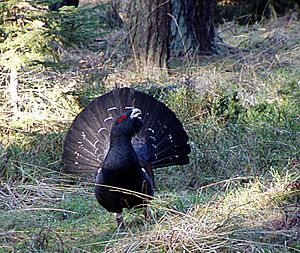Galliformes facts for kids
Quick facts for kids Galliformes |
|
|---|---|
 |
|
| Male Grey Junglefowl, Gallus sonneratii | |
| Scientific classification | |
| Kingdom: | |
| Phylum: | |
| Class: | |
| Order: |
Galliformes
Temminck, 1820
|
| Families | |
Galliformes is a group of birds that includes familiar birds like turkeys, grouse, chickens, quails, and pheasants. There are over 250 different kinds of these birds living all around the world. Most Galliformes birds have four toes. They have three long toes in the front for digging and scratching. A shorter toe is found at the back.
Contents
Discover the Galliformes Bird Order
These birds often look like chickens. They have rounded bodies and wings that aren't very pointed. Their size can vary a lot. Some are as small as 15 cm (6 inches), while others can be as large as 120 cm (4 feet).
Galliformes birds mostly live on the ground. Their wings are short and rounded. This design helps them fly short distances quickly. Some adult males even have sharp spurs on their legs. They use these spurs for fighting.
These birds can live in many places. You can find them in forests, deserts, and grasslands worldwide. In the wild, they usually live for 5 to 8 years. But in places like zoos, they can live up to 30 years!
They communicate using different sounds and body movements. These actions help them find mates, fight, protect their territory, and care for their young.
How Galliformes Birds Live and Eat

Galliformes birds eat many different things. Their diet includes fruits, seeds, leaves, and flowers. They also enjoy insects, snails, worms, and even small lizards or snakes. Some might even eat small rodents or other birds' eggs.
The smallest Galliformes bird is the king quail (Coturnix chinensis). It's only about 13 cm (5 inches) long. It weighs just 28–40 g (1–1.4 oz). The largest is the North American wild turkey (Meleagris gallopavo). This big bird can weigh up to 14 kg (30.5 lb). It can also be over 120 cm (47 inches) long.
The green peafowl (Pavo muticus) likely has the longest wingspan. It also has the longest overall length, with a tail that can be over 6 feet! Most Galliformes birds are plump with thick necks. They have moderately long legs and short, rounded wings. Birds like grouse, pheasants, and partridges fit this description well.
Flight and Movement of Galliformes
Most Galliformes birds prefer to walk and run. They don't fly long distances very often. However, they are very good at their special way of flying. They have strong flight muscles. Some species even migrate, flying long distances when seasons change.
There are no living Galliformes birds that cannot fly. But some ancient relatives of these birds were flightless. For example, Sylviornis was a huge, flightless bird from New Caledonia. It became flightless because it was so big. Its wings became smaller as a result.
Another group of huge, flightless birds was the Australian mihirungs. These giant plant-eating birds were among the largest birds ever. They also had very small wings.
Galliformes Behavior and Life
Most Galliformes birds stay in one area. They don't move around much. But some smaller species, like quails, do migrate over long distances. Birds living in mountains often move to different altitudes. This helps them find food and water.
Some Galliformes birds are great at walking long distances every day. These include New World quails, guineafowl, and eared pheasants. They can travel many miles on foot.
Birds like the crested fireback and malleefowl are similar in body shape. They have long, thin necks and legs. They also have large, wide wings. This helps them live in grassland habitats.
Some species show only small differences between males and females. These birds often need to travel widely to find food. Other species stay in one place but change a lot with the seasons. These birds often have big differences in size or looks between males and females.
Winter Survival for Galliformes
Galliformes birds are well-suited for cold winters. Their larger size and thicker feathers help them stay warm. They also become less active to save energy. In winter, they can change what they eat. They become like "ruminants," which means they can digest tough plant material. This includes things like tree buds, twigs, and pine needles. This gives them plenty of food that is easy to find.
What Galliformes Eat

Most Galliformes birds eat plants, but some also eat a little bit of meat. They have short, thick beaks. These beaks are perfect for digging in the ground for roots or eating plants. Young birds will also eat insects.
Some Galliformes, like peafowl and junglefowl, have different food needs. The Himalayan monal digs in rotting wood to find invertebrates. Other birds like the cheer pheasant and crested partridge also search for insects in rotting wood. They look for termites, ants, beetle larvae, and snails.
Some Galliformes have narrow, delicate beaks. These birds prefer to catch live insects in leaf litter or shallow water. The blue peafowl is famous in India for eating snakes, even poisonous cobras! It uses its strong feet and sharp beak to defeat them. Wild turkeys and domestic hens also eat insects, mice, lizards, and amphibians.

Some Galliformes, like Tragopans and certain grouse, mostly eat plants from trees. Grouse are special because they can eat plants that are toxic to other animals. These include plants like sagebrush or pine trees. Many species also find food in tree canopies. This is especially true when it's snowy or rainy.
Galliformes Reproduction and Life Cycle
Most Galliformes birds have many babies. They often lay more than 10 eggs in one clutch. Unlike many birds that mate for life, Galliformes often have one male mating with several females.
Galliformes chicks are very active soon after hatching. They can walk and follow their mothers just hours after being born. The most amazing example is the Megapodiidae family. The parents don't sit on the eggs to keep them warm. Instead, they bury their eggs in mounds of rotting plants, warm volcanic ash, or hot sand. The chicks have to dig their way out of these mounds. But when they emerge, they are fully feathered and can even fly!
Images for kids
-
Female (left) and male common pheasants show clear differences in looks.
-
The wild turkey is a close relative of pheasants.
-
A group of helmeted guineafowl looking for food.
-
During mating season, the male western capercaillie eats mostly bilberry leaves. These are poisonous to most plant-eaters.
See also
 In Spanish: Gallináceas para niños
In Spanish: Gallináceas para niños








